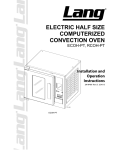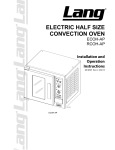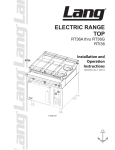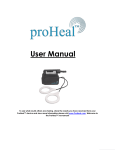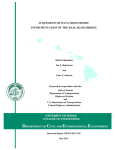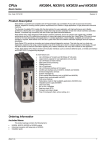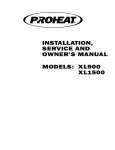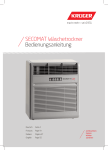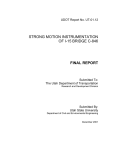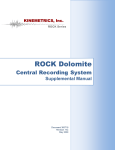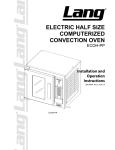Download Shallow Borehole EpiSensor
Transcript
User Guide Shallow Borehole EpiSensor Force Balance Accelerometer Model SBEPI Document 301934 January 2005 Revision B Trademarks This manual copyright © Kinemetrics, Inc., 2002. All rights reserved. Kinemetrics products are covered by U.S. and foreign patents, issued and pending. Printed in U.S.A. The trademarks used throughout this manual, registered or not, are: Kinemetrics, QuickTalk™, QuickLook™, K2™, Mt. Whitney™, Etna™, SBEPI™, EpiSensor™ FerriShield Microsoft Windows Kinemetrics, Inc., 222 Vista Avenue, Pasadena, CA 91107 USA Phone: (626) 795-2220 Fax: (626) 795-0868 E-mail: [email protected] Website: www.kinemetrics.com Kinemetrics SA, Le Tresi 3, 1028 Preverenges, Switzerland Phone: 21.803.2829 Fax: 21.803.2895 E-mail: [email protected] DOCUMENT 301934, REVISION B Table of Contents Safety 1. Introduction The SBEPI .....................................................................................................1 Inspecting the SBEPI .....................................................................................2 2. Installation Accessory Kit.........................................................................................5 Inspecting the Cable End ...............................................................................5 Electrical Connection.....................................................................................6 Functional Check & Zero Offset Measurement.............................................6 Accelerometer Adjustments...........................................................................7 SBEPI Installation..........................................................................................9 3. Operating Basics Power Requirements ....................................................................................11 Electrical Connection...................................................................................11 Cable Wiring........................................................................................12 Polarity Conventions....................................................................................13 Configurations..............................................................................................14 Performing a Functional Test with an Altus Recorder ................................14 Sensor Response Test ..................................................................................15 Using the SBEPI Calibration Coil ...............................................................16 4. Maintenance Recommended Maintenance........................................................................19 Complete a Functional Test .................................................................19 DOCUMENT 301934, REVISION B Desiccant Replacement ....................................................................... 19 Troubleshooting and Repair ................................................................ 20 Examining & Cleaning the O-rings..................................................... 20 5. Reference Theory of Operation .................................................................................... 21 Working Principle ............................................................................... 22 Features ............................................................................................... 23 Pole Zero Representation of the SBEPI ..................................................... 24 SBEPI Configuration................................................................................... 26 Opening the SBEPI Case..................................................................... 27 SBEPI DIP Switch & Jumper Selectable Options .............................. 27 Full Scale Voltage Output Voltages.................................................... 29 Factory Configured Power Supply Options ........................................ 30 Calibration Coil ........................................................................................... 30 Power Supply ...................................................................................... 31 Resistive Cable Loss ........................................................................... 32 Using Non-Kinemetrics Data Loggers ............................................... 33 Output Voltage .................................................................................... 33 Calibration Sequence........................................................................... 34 Ground Loop Prevention..................................................................... 35 Appendix A Figures Figure 1: Figure 2: Figure 3: Figure 4: Figure 5: The SBEPI .................................................................................... 2 Accelerometer Adjustment Screws............................................... 7 SBEPI Polarity Convention Fix Dimensions.............................. 13 Display of Functional Test.......................................................... 14 Display of Functional Test Using Software Released Prior to August 1998......................................................................... 15 Figure 6: Simplified Block Diagram of an Accelerometer ........................ 21 Figure 7: Amplitude, Phase, and Step Response of the SBEPI Response Model ................................................................................. 25 Figure 8: Location of DIP Switches and Jumpers...................................... 28 DOCUMENT 301934, REVISION B Tables Table 1: Table 2: Table 3: Table 4: Table 5: Table 6: Table 7: Table 8: Accessories .....................................................................................5 SBEPI Assembly Wiring Chart ....................................................12 DIP Switch and Jumber Settings ..................................................29 Range/Sensitivity Calculations.....................................................30 Current Requirements...................................................................31 Current Requirments.....................................................................32 SBEPI Cabling Requirements (1 Foot = 0.3048 Meters) .............33 SBEPI Specifications....................................................................37 Safety Symbols & Terms The following symbols may appear on Kinemetrics equipment or in this manual. ! When you see this symbol, pay careful attention. Refer to the similarly marked, relevant part of this manual before servicing the instrument. This symbol means a low-noise earth ground. The noted item should be grounded to ensure low-noise operation, and also to serve as a ground return for EMI/RFI and transients. Such a ground does not work as a safety ground for protection against electrical shock! ~ This symbol means an alternating current (AC) power line. This symbol means a direct current (DC) power line derived from an AC power line. This symbol indicates an electrostatic sensitive device (ESD), meaning that when handling the marked equipment you should observe all standard precautions for handling such devices. These safety-related terms appear in this manual: Note: statements identify information that you should consider before moving to the next instruction or choice. Caution statements identify conditions or practices that could result in damage to the equipment, the software, or other property. WARNING! statements identify conditions or practices that could result in personal injury or loss of life. SHALLOW BOREHOLE EPI USER GUIDE SAFETY 1 Specific Precautions Follow the precautions below to ensure your personal safety and prevent damage to the Shallow Borehole EpiSensor. Power Source The Shallow Borehole EpiSensor (SBEPI) must be supplied with power either from a recorder or from a customer-supplied ± 12V or ± 15V power supply (or a + 12V supply for the single-supply option). If you plan to power the SBEPI from a recorder, connect the recorder to a power supply/charger supplied by Kinemetrics, as described in each recorder's user manual. To supply power directly to the SBEPI, you need a low-noise, regulated ± 12V or ± 15V power supply (or a + 12V supply for the single-supply option) that is safely grounded and meets all applicable local regulations. The SBEPI will be damaged if the power is connected with the wrong polarity. User-Supplied Power/Charging System If you supply your own power/charging system, be sure that the system provides the correct voltage and current required by the SBEPI under all operating conditions. You are responsible for the safety of your charging system. If you get power from the mains supply, be sure you have supplied adequate grounding for all the equipment. If you supply your own batteries, follow the manufacturer’s safety recommendations. ! Sensor Grounding and Cabling In some cases the SBEPI will be a long distance from the recorder. In these installations it is possible, due either to faulty AC wiring or extremely high earth-return currents, for a high potential difference to exist between the grounds at the two locations. When the cable is grounded at one end a potentially lethal voltage can exist between the other end of the cable and ground. Consider this danger during installation and get help from a qualified electrician if this danger exists. Do Not Operate in Explosive Atmosphere The SBEPI provides no explosive protection from static discharges or arcing components. Do not operate the equipment in an atmosphere where explosive gases are present. SAFETY 2 SHALLOW BOREHOLE EPI USER GUIDE Sicherheit Symbole & Begriffe Diese Symbole können auf Kinemetrics Geräte oder in diesen Manuel erscheinen: ! Bedeutet Achtung! Wenn sie dieses Symbol auf ein Gerät sehen, muss den gleich markierten Teil dieses Manuels beachet werden. Bevor irgend eine Unterhaltsarbeit angefangen wird, muss dieser Teil des Manuels gelesen werden. Wenn Sie dieses Symbol sehen, bitte besondere Achtung geben. Bedeutet Erdung. Das erwaente Teil sollte geerdet werden, um eine “low-noise” operation zu versichern, und dann auch als Erdung für EMI/ FRI und Transienten und solch eine Erdung wird nicht als Sicherheit gegen elektrischen Schock dienen! ~ Bedeutet Wechselstromzufuhr (AC) mit Elektroschock Gefahr. Bedeutet Gleichstromzufuhr von AC Versorgung herkommend. Bedeutet Elektrostatisch Sensibeles Element (ESD) für dessen Handhabung alle vorbeugende Vorsichtsmassnahmen genommen werden müssen. Folgende Darstellungen werden in diesen Manuel erscheinen: Note: Darstellung welche Informationen Sie erhalten, die besonders beachtet werden müssen, bevor sie zum nächsten Schritt gehen. Caution: Darstellung bei dem die Missachtung in der Regel Gefahr für Defekte und Störungen im Gerät, Programm oder Zubehör besteht. WARNING! Darstellung bei dem die Missachtung in der Regel Verletzungs – oder Lebensgefahr besteht. SHALLOW BOREHOLE EPI USER GUIDE SAFETY 3 Spezielle vorbeugende Massnahmen Alle vorbeugende Massnahmen müssen beachtet werden. Für Ihre persönliche Sicherheit, und um Schäden im Shallow Borehole EpiSensor (SBEPI) zu vermeiden. Stromversorgung Die SBEPI muss entweder mit Strom von einem Accelerograph oder Ihrer eigenen Stromquelle ±12 V versorgt werden. Sollten Sie planen, die SBEPI mit Strom von einem Recorder zu versorgen, verbinden Sie den Recorder mit unserem Kinemetrics Stromladegerät, wie es in unserem “User Manuel” beschrieben ist. Um die SBEPI direkt mit Strom zu versorgen, müssen Sie ein Ladegerät ±12 V, welches mit allen Sicherheitsbedingunge ausgestattet ist, benutzen. Optionelles Stromversorgungs/Ladegerät In manchen Fällen wird die SBEPI eine lange Strecke von dem Recorder entfernt Sein, wo es dann möglich sein könnte, dass durch beschädigte AC-Wiring oder Hohe Erdbewegungen, ein Spannungsunterschied besteht. Es ist daher unbedingt notwendig, dass alle angeschlossenen Instrumente am gleichen Spannungspotential geerdet sind. Bitte folgen Sie den vom Hersteller gegebenen Empfehlungen. ! Verkablung und Erdung vom Sensor Wenn das Kabel an einem End geerdet ist, kann ein verhältnismässig grosser Unterschied in der Voltage bestehen, welcher sehr gefährlich ist. Bitte beachten Sie Diese Gefahr und wenn nötig, ziehen Sie das Gutachten eines qualifizierten Elektrikers Ein. Nicht in explosionsgefährdete Umgebung gebrauchen Der SBEPI hat keinen Explosions-schutz von statischen Entladungen oder funkgefährdeten Bauteilen. Benutzen sie die Geräte nicht in Umgebungen mit explosiven Gasen. SAFETY 4 SHALLOW BOREHOLE EPI USER GUIDE Seguridad Símbolos & Términos Estos símbolos podrían aparecer en los equipos Kinemetrics o en este manual: ! Significa poner atencion! Cuando Usted vea este símbolo en el instrumento, referirse a las partes de este manual marcadas similarmente. Antes de intentar cualquier servicio en este instrumento, Usted tiene que leer las partes relevantes de este manual. Si Usted ve este símbolo, ponga atención cuidadosamente. Significa un polo a tierra de bajo ruido. El ítem referido debe estar polarizado a tierra para asegurar la operación a bajo ruido y además sirve como un retorno a tierra para el EMI/RFI y transitorios. Tal polo a tierra no trabaja como un polo a tierra de seguridad para protección contra choques eléctricos! ~ Significa una línea de energía de Corriente Alterna (AC). Significa una línea de energía de Corriente Directa derivada de una línea de energía AC. Significa una Unidad Sensitiva a Electrostática (Electrostatic Sensitive Device ESD), indicando que usted debe tener cuidado y observar todas las precauciones para el manejo de tales unidades. Estos términos aparecerán en este manual: Note: sentencias identificando información que Usted debe considerar cuidadosamente antes de dirigirse a la siguiente instrucción u opción. Caution: sentencias identificando condiciones o practicas que podrían resultar en daño del equipo, el software u otra propiedad. WARNING! sentencias identificando condiciones o practicas que podrían resultar en una lesión personal o la perdida de la vida. SHALLOW BOREHOLE EPI USER GUIDE SAFETY 5 Los últimos dos términos mencionados arriba podrían también aparecer en el equipo Kinemetrics que Usted ha comprado, pero no necesariamente ⎯ indiferentemente, Usted debe definitivamente tomar notas serias de las precauciones y advertencias en este manual. Precauciones Específicas Siga las precauciones a continuación para garantizar su seguridad personal y prevenir daños al Shallow Borehole EpiSensor (SBEPI). Fuente del poder El SBEPI debe ser alimentado con energía ya sea desde un registrador o desde una fuente de ± 12V provista por el usuario. Si usted planea alimentar el SBEPI desde un registrador, conecte el registrador a una fuente de poder/cargador suministrado por Kinemetrics, como se describe en cada manual del usuario para el registrador. Para suministrar energía directamente al SBEPI, usted necesita una fuente de poder de bajo ruido y regulado ± 12V, el cual debe ser apropiadamente conectado a tierra y cumplir con todas las regulaciones locales que apliquen. Sistema de Poder/Carga Provisto por el Usuario Si usted provee su propio sistema de poder/carga, usted tiene que estar seguro, que el sistema proporciona el voltaje correcto y la corriente requerida por el SBEPI bajo todo las condiciones de operación. Usted es responsable por la seguridad de su sistema de carga. Si usted deriva energía de suministro principal, usted tiene que asegurarse que ha provisto un polo a tierra adecuado para todo el equipo. Si usted suministra sus propias baterías, siga las recomendaciones de seguridad del fabricante. ! Cableado y Polo a Tierra del Sensor En algunos casos el SBEPI estará a una distancia lejos del registrador. En estas instalaciones existe la posibilidad de una elevada diferencia de potencial entre dos localidades de polo a tierra, debido ya sea a fallas en el alambrado del AC o corrientes de un extremadamente alto retorno de tierra. Cuando el cable esta polarizado a tierra en uno de sus lados terminales, un voltaje potencialmente letal puede existir entre el otro lado terminal del cable y el polo a tierra. Considere este peligro durante la instalación y obtenga ayuda de un electricista calificado si este peligro existe. No Opere en Atmósferas Explosivas El SBEPI no proporciona ninguna protección explosiva para descargas estáticas componentes que generen arcos eléctricos. No operar el equipo en una atmósfera de gases explosivos. SAFETY 6 SHALLOW BOREHOLE EPI USER GUIDE Sécurité Symboles & Terminologie Les symboles suivant peuvent figurer sur les équipements Kinemetrics ou dans ce manuel: ! Signifie Attention! Quand vous rencontrez ce symbole sur un instrument, veuillez vous référer à la section de ce manuel signalée par la même marque. Avant même d’effectuer la première opération sur l’instrument, vous devez lire la section correspondante de ce manuel. Faite attention si vous voyez cet symbole. Indique une mise à la terre “faible bruit”. Les objets portant cette marque doivent être reliés à la terre afin d’assurer un fonctionnement optimal. Elle est aussi utilisée pour les éléments de protection contre les interférences magnétiques, les perturbations hautes fréquences radio et contre les surtensions. Cette mise à terre n’est pas une mise à terre de sécurité pour une protection contre les choques électriques! ~ Indique une alimentation en courant alternatif (AC). Indique une Alimentation en courant continu (DC) dérivée d’une alimentation alternative Indique la présence d’un composant sensible aux décharges électrostatiques (ESD), Cela signifie qu’il faut observer toutes les précautions d’usage en manipulant ce composant. Les termes suivant apparaissent dans ce manuel: Note: Indique la présence d’une information que vous devez particulièrement considérer avant de passer à la prochaine instruction or operation. Caution: Indique une condition ou opération qui peut entraîner des dommages à votre équipement, au logiciel ou à d’autres propriétés . SHALLOW BOREHOLE EPI USER GUIDE SAFETY 7 WARNING! Indique une condition ou opération qui peut entraîner des blessures corporelles ou la perte de la vie. Les deux derniers termes mentionnés peuvent apparaître sur les équipements de Kinemetrics que vous avez acquis, mais pas nécessairement ⎯ indifféremment, il est conseillé de prendre au sérieux les avertissements de ce manuel. Précautions Spécifiques Observez toutes les précautions suivantes afin d’assurer votre sécurité personnelle et d’éviter des dégâts aux composants de votre capteur Shallow Borehole EpiSensor (SBEPI). Alimentation Le SBEPI doit être alimenté avec un courant de ±12 VDC fourni par l’enregistreur ou par votre propre système d’alimentation. Si vous alimentez le SBEPI avec l’enregistreur, connectez l’enregistreur en utilisant le système d’alimentation fourni par Kinemetrics, et decrit dans le manuel d’utilisation délivré avec l’enregistreur. Pour fournir une alimentation au SBEPI, vous avez besoin d’une source à faible bruit ± 12V avec une mise a la terre adéquate et qui remplit les conditions de la reglementation locale. Option Systéme d’ alimentation fourni par l’utilisateur Si vous fournissez votre système d’alimentation, vous devez vous assurez que le système fournit une tension et un courant requis par le SBEPI. Veuillez noter que vous serez seul responsible pour la sécurité de votre système d’alimentation. Si vous utilisez le courant du réseau d’alimentation principal, vous devez vous assurez d’installer les mises a la terre adéquates pour tout votre equipement. Si vous utilisez vos batteries, vous devez vous référer aux recommendations fournis par le fournisseurs. ! Mise à la terre et connection du capteur Dans certain cas, le capteur SBEPI est installé à distance de l’enregistreur. Dans ces installations il est possible, soit a cause d’une connection défectueuse au système d’alimentation principale où d’un fort courant de retour à la terre, pour une difference de potentiel qui existe entre la mise à la terre aux deux locations. Quand le cable est mise à la terre d’un coté, une tension potentiellement fatale peut exister entre l’autre coté du cable et la terre. Considerez ce danger pendant l’installation et demandez l’aide d’un electricien si ce danger existe. Ne Pas Utiliser en Atmosphère Explosif Le SBEPI ne comprend pas de protection contre les explosions dues aux décharges statiques ou aux composants pouvant provoquer des arcs. Ne pas utiliser ces composants en présence de gaz explosifs. SAFETY 8 SHALLOW BOREHOLE EPI USER GUIDE DOCUMENT 301934, REVISION B 1. Introduction The User’s Guide to the Shallow Borehole EpiSensor contains the information necessary to operate and install the Shallow Borehole EpiSensor (SBEPI) triaxial borehole seismic sensor. Kinemetrics also produces a triaxial EpiSensor FBA ES-T, a uniaxial EpiSensor FBA ES-U, and the HypoSensor deep borehole package. Kinemetrics’ strong motion accelerographs feature a triaxial EpiSensor Altus deck. Kinemetrics is committed to ensuring a successful installation. For assistance with planning, installation, operation or maintenance, contact us at the locations listed in the front of this manual. We also have an extensive Services Group that can install, maintain, and analyze the data from your SBEPI. This chapter provides an overview of the SBEPI and inspection instructions. The SBEPI The SBEPI is a triaxial accelerometer optimized for seismic applications. Inside the stainless steel housing are three orthogonally mounted low-noise EpiSensor force balance accelerometer modules. The housing, cables and connections are rated to 140 PSI (1 MPa), equivalent to a depth of 330 feet (100 meters). The –01 version comes supplied with a 40 meter cable, the –02 with a 110m cable. The SBEPI has factory selectable full scale recording ranges of ±4g, ±2g, ±1g, ±1/2g or ±1/4g. The SBEPI bandwidth of DC to 200 Hz is a significant improvement over earlier generations of sensors. The output voltage levels are user-selectable at either ±2.5V or ±10V single-ended, or ±5V or ± 20V differential. The SBEPI is normally powered with a ±12V external DC power source (-8 Versions). A single +12V power supply is available as an option. (-18 Unit) The unit has a nominal diameter of 2.640” (67 mm) and a case length of approximately 9.5” (241 mm). This allows it to be used with 3” ID cased holes. Full specifications for the unit can be found in the Appendix. SHALLOW BOREHOLE EPI USER GUIDE 1 DOCUMENT 301934, REVISION B Figure 1: The SBEPI Inspecting the SBEPI Carefully remove the SBEPI from its shipping container. Although Kinemetrics takes every precaution in packing its systems, shipping damage can still occur. If you find a problem, note the condition of the shipping container. Then contact the freight forwarder and Kinemetrics as soon as possible. Examine the SBEPI. Its case should appear securely sealed, showing no sign of dents or other damage. 2 SHALLOW BOREHOLE EPI USER GUIDE DOCUMENT 301934, REVISION B SBEPI units should always be transported in the original shipping container to avoid damage. The SBEPI is shipped with an accessory kit that includes a zero-adjustment tool, spare O-rings, silicone grease, replacement desiccant, and a special wrench for removing the sensors from the stainless steel housing. SHALLOW BOREHOLE EPI USER GUIDE 3 DOCUMENT 301934, REVISION B 2. Installation This chapter contains information relevant to the installation of the SBEPI unit. Our Services Group can provide additional expertise and borehole services. This chapter covers the following information: Accessory Kit Electrical Connection Functional check and zero offset measurement Accelerometer adjustment SBEPI installation Accessory Kit The SBEPI is shipped with the following accessories. These items are required for installation of the unit. Please contact Kinemetrics for replacement kits. Table 1: Accessories Kinemetrics P/N Quan. Item Purpose 110393 1 Allen wrench Tool for adjusting the zero offset 700281-142 2 O-ring Seals the sensor to the main housing 870513 2 Backup Ring Seals the sensor to the main housing 110582 1 Spanner wrench Tool for opening unit 700403 2 Desiccant Maintain Humidity Free Interior Inspecting the Cable End Before lowering the instrument into its hole, inspect the unit and the cable end, make sure the cable insulation is not damaged Test the unit by making the electrical connections as follows: SHALLOW BOREHOLE EPI USER GUIDE 5 DOCUMENT 301934, REVISION B Electrical Connection Stand the package up so that it is vertical within ±1-1/2°. Use temporary braces or blocking to keep the package in this upright position while checking its operation. A one-foot length of 3" PVC casing mounted to a wood base works well as a support. Connect power as indicated in the Operating Basics section. Functional Check & Zero Offset Measurement Measure and record the output voltage from each accelerometer with a digital voltmeter. 2 Compute the offset of each axis in units of g (1g = 9.8 m/s ). Divide the output voltage (V) by the sensitivity of the SBEPI (V/g) quoted on the data sheets sent with the unit. For example, if you have a unit with a sensitivity of 20 V/g and an offset voltage of 1 V, the offset would be 0.050 g -- often stated as 50 milli g. The higher of 50 milli g offset or a 50mV voltage offset serves as a reasonable threshold for opening the package and re-zeroing the sensors, but this may vary from application to application. Connect the SBEPI to a data logger and perform the functional tests described in Chapter 2. If junction boxes (P/N 108375 and 105058) are used with the system, we recommend that they be connected to the circuit now to be sure that the whole circuit is operational. They also allow other voltages to be easily measured. Perform a simple tilt test to check that all three axes are functioning properly and that the channels are wired correctly. The horizontal sensors will undergo ±1g acceleration when tilted through 360°. The vertical sensor should measure 1g when the package is tilted on its side and 2g when the unit is inverted. If all three accelerometers have acceptable offsets for your application, and the tilt and functional response tests agree with the original calibration records, proceed with the installation. If the offsets and functional responses do not fall within acceptable ranges, zero the accelerometers as described in the next section. 6 SHALLOW BOREHOLE EPI USER GUIDE DOCUMENT 301934, REVISION B Accelerometer Adjustments This section describes a step-by-step procedure to adjust the SBEPI in the field. Remove the cylindrical housing from the package using the special spanner wrench (110582) supplied in the accessory kit and a strap wrench. Figure 2: Accelerometer Adjustment Screws SHALLOW BOREHOLE EPI USER GUIDE 7 DOCUMENT 301934, REVISION B Caution: Under no circumstances remove the studs and use the threaded holes to unscrew or tighten the package into the housing. This could loosen the plastic coating and cause the unit to leak. Use the supplied spanner wrench (110582) to loosen the unit by attaching it over the studs. Caution: Potential electrostatic discharge (ESD) hazard to equipment. Wear a grounded wrist strap with impedance of approximately 1 M Ω when handling the SBEPI circuit boards to protect components from damage. Connect the required power to the cable (or connect the cable to a recorder). Stand the accelerometer framework against a vertical surface. Be very careful that it does not fall over. The assembly should be level within 0.5°. Measure the "zero" output voltage with a digital voltmeter. Adjust the modules using the adjustment holes shown in Figure 2. Adjusting the vertical sensor is more difficult than adjusting the horizontal sensors because the hex wrench is partially obstructed by one of threaded rod supports. Turning the adjustment screw clockwise will result in a more positive output. After you have adjusted the screw tap the case with the hex wrench or a screwdriver handle to ensure the adjustment screw is “set” in position. To convert the value to units of g, divide the measured value by the sensitivity. With some care, the channels can be adjusted to an offset of less than 5 milli-g. This corresponds to a tilt in the horizontal channels of 0.29° – more than sufficient for a borehole installation. If you decide to leave a higher offset than 5 milli g it will not affect your data quality. The only thing a high offset does is reduce the highest signal that you can record, but for any reasonable offset this is a very small change. For example with a 1g full scale range and a 100mg offset the largest signal you can record will now be 0.9g versus 1g for a perfectly balance accelerometer. Replace the cylindrical housing, being careful not to damage the O-rings or backing rings near the top of the sensor stack. If the O-Rings are new apply silicon grease (880718) to ensure easy assembly. Be very careful not to gall or cross the threads of the stud when screwing the package together. If the package appears to jam before it is fully engaged in the tube, do not attempt to force the package in further. If you encounter resistance, unscrew the package, remove any debris on the stud threads and be sure there is a thin coat of grease on them. Use a strap wrench and the spanner wrench provided with the unit. 8 SHALLOW BOREHOLE EPI USER GUIDE DOCUMENT 301934, REVISION B SBEPI Installation When the accelerometers are working correctly, the package can be lowered into the hole. If you are using Kinemetrics equipment such as loading poles or a hole lock to install the package, follow the instructions included with those options. The following instructions make a number of assumptions: That the package is lowered into the hole with either the Kinemetricssupplied cable, or The package weight is supported by a stainless steel wire tension member That the hole has been cased with PVC and filled with water to support the casing Other recommended procedures: Case the holes with 20-foot sections of 3-inch (90 mm) schedule 40 (3.500-inch OD × 3.042-inch ID) PVC pipe glued together with couplings between segments Glue a cap to the bottom segment Grout the casing into the hole with a bentonite mixture that will have the same strength as soil A grout mixture that has proved satisfactory in the past is specified in ASTM D-4428/4428M. The proportions are: 1 pound bentonite 1 pound Portland cement 3 quarts water Restrain the package while carefully lowering it through the hole casing to the bottom of the hole. The unit can be powered or unpowered during the decent. One person can successfully lower the package into holes up to 300 feet if the casing has been filled with water due to the offsetting weight of the buoyancy of the cable and package. The apparent weight of the package and 300 feet of cable is only approximately 35 pounds. This process is easier if the package is fitted with the appropriate optional centering spiders that keep it centered in a 3 or 4-inch inside-diameter cased hole. The accelerometers should be balanced to within the acceptable tolerance. This tolerance will vary with each application. If this is not the case, it indicates that the hole orientation is not vertical. The accelerometers must be compensated for this offset. Record the offset at the bottom of the hole, remove the package, and "zero" the accelerometers to the negative of the downhole offset. SHALLOW BOREHOLE EPI USER GUIDE 9 DOCUMENT 301934, REVISION B Note: This procedure will only work if the package can be returned to the same angular orientation down the hole, which will require loading poles. Although we recommend using loading poles to get a specific orientation, it is not absolutely necessary. It is possible, to utilize earthquakes to determine the orientation of the package after it is installed. When the accelerometers are correctly balanced and the package orientation is satisfactory, lock it in place with a suitable material, such as small glass or smooth rock spheres (<1/4-inch diameter). This material will allow you to retrieve or move the SBEPI package at a future date. If you wish to cement the package into place permanently, we strongly recommend that you first test the installation for at least two or three weeks. If you do choose to cement the package permanently, use enough material to fill the cavity between the package and the casing completely and to leave some material on top of the package. Because of its rough surface, ordinary gravel may not "flow" into the area between the package and the casing, while sand may liquefy in a strong motion event. 10 SHALLOW BOREHOLE EPI USER GUIDE DOCUMENT 301934, REVISION B 3. Operating Basics The SBEPI is designed as a very flexible, low-noise accelerometer and can be configured to satisfy a wide variety of acceleration-sensing requirements. This chapter is organized as follows: Power requirements Electrical connections Polarity conventions Description of configurations Functional test with an Altus recorder Using the calibration coil Power Requirements The SBEPI is supplied in two power configurations. The basic unit (-08) requires +/-12 V for operation. An optional internal DC/DC converter (in the – 18 unit) allows operation with only +12 V. The data sheet sent with the unit indicates whether it is a dual or single supply version. If it is a single supply unit, it is also shipped with a label on the cableend of the sonde. Note: This label may fall off after repeated installation of the unit. If you have any doubt about the power configuration, call Kinemetrics. It is essential that the unit be supplied with adequate power. Be sure to take into account any power loss that might occur due to the cabling. Electrical Connection The connections for the SBEPI are described below; along with procedures for using the calibration and cal enable signals. This information should be sufficient to allow the SBEPI to connect to the user's own equipment or any Kinemetrics recorder. SHALLOW BOREHOLE EPI USER GUIDE 11 DOCUMENT 301934, REVISION B Cable Wiring The wiring colors of the SBEPI cable assembly are provided below. To aid in connecting this system to a transient protection box (P/N 108390), the corresponding connections on J3 and J4 in the box are also shown in the table, along with connections to an Altus external input board. Table 2: SBEPI Assembly Wiring Chart K2 External FBA Option J1 SBEPI Cable 700422 J1, J3 Cable Assembly Wiring Chart Cable wire colors on 700422 Function Internal P3 Pin L 1 TP2 White X+ signal 6 M 2 TP2 Black X− signal 8 U 3 TP2 Shield Shield 10 A 4 TP3 Green Y+ signal 3 B 5 TP3 Black Y− signal 1 U 6 TP3 Shield Shield 10 C 7 TP5 Yellow Z+ signal 7 D 8 TP5 Black Z− signal 5 U 9 TP5 Shield Shield 10 K 13 TP4 Blue Common 12 K 13 TP4 Black Common 12 TP4 Shield Shield 10 U E 10 TP6 Brown CALDAC 2 F 11 TP6 Black CCE 4 TP6 Shield Shield 10 U J 12 TP1 Red +12V 11 H 14 TP1 Black -12V * 13 TP1 Shield Shield 10 Cable shield Shield N/C U U 15 * Note: Connect only at sensor end for single supply option. N/C at recorder end. OK to connect sensor to well head box. 12 SHALLOW BOREHOLE EPI USER GUIDE DOCUMENT 301934, REVISION B Polarity Conventions Unlike previous generations of Kinemetrics force balance accelerometers, the SBEPI uses a right-handed, X Y, Z coordinate system with a positive output for acceleration along each axis. Previous Kinemetrics FBA designs used an alternate coordinate system (L, V, T) and produced a negative output for positive acceleration along each axis. With modern feedback sensors, this convention dating from the days of passive seismic sensors is losing acceptance. Today's user requires an accelerometer that produces useful data without regard to the internal workings of the sensor. The extended bandwidth, flat frequency response and polarity of the SBEPI meet these demands. Figure 3: SBEPI Polarity Convention SHALLOW BOREHOLE EPI USER GUIDE 13 DOCUMENT 301934, REVISION B Configurations The SBEPI can be configured to obtain a variety of output types and sensitivities. The variety of configurations is described in more detail in the Reference section of this manual. The data sheet provided with your unit indicates the sensitivity of the sensor. This can be checked with the results of the functional test described in the next section. We recommend that you do not alter the factory settings of the SBEPI. Performing a Functional Test with an Altus Recorder Please refer your recorder's user manual for instructions on performing functional tests. Altus instrument firmware released after August 1, 1998 performs a dual polarity pulse test on SBEPIs as the standard functional test when correctly configured. This firmware is available at the Kinemetrics website. Figure 4: Display of Functional Test The height of the pulse will depend on the full-scale setting of the instrument but will correspond to a g level of approximately 0.125g. The exact value will be 2.5V multiplied by the sensor module's calibration coil sensitivity value provided on the sensor's data sheet. 14 SHALLOW BOREHOLE EPI USER GUIDE DOCUMENT 301934, REVISION B Altus software released prior to August 1998 supports functional tests on the earlier generation of Kinemetrics force balance accelerometers but does not support the SBEPI. If you perform a functional test or sensor response test on an SBEPI using older software, the record will appear as in the screen in Figure 5. Figure 5: Display of Functional Test Using Software Released Prior to August 1998 The record looks like this because the calibration coil enable is only enabled during the undamped portion of the old FBA-11 style functional test. Sensor Response Test The sensor response test for the SBEPI using Altus software released after August 1, 1998 measures the response of the sensor to white noise input. The digital-to-analog converter in the recorder drives the calibration coil with an analog voltage corresponding to a pseudo-random number sequence. The resulting file contains the information needed to compute the sensor response. SHALLOW BOREHOLE EPI USER GUIDE 15 DOCUMENT 301934, REVISION B Using the SBEPI Calibration Coil This section contains the information necessary to use the calibration coil with equipment other than Altus recorders, such as a spectrum analyzer or a different type of data logger. Each EpiSensor module is equipped with a calibration coil. This coil is isolated from other circuitry and accurately simulates the effect of an acceleration on the system. This coil can be used to verify both the static acceleration sensitivity of the EpiSensor and the dynamic response of the system. The Altus recorder functional and system tests use a calibration signal from the recorder's digital-toanalog converter (DAC). To produce a functional test sequence, the recorder must control the CAL and CCE line to the SBEPI. Even if the recorder cannot produce a functional test, it is still very important that these lines be held at the correct potential. The CAL line is not connected to the sensor unless the CCE line is active, but to provide the best noise performance the CAL line should not be left floating. We suggest that the CCE line be grounded to power common when the calibration coil is not in use. The CCE line drives a transistor that operates an analog switch that connects the CAL line to the sensor module calibration coil. The transistor will turn on the analog switches at voltages between +5 to +12V. The transistor is not activated at voltages below 0.5V. This means a CMOS driver can drive the line or an open collector output pulled up to 12V. A transistor-transistor logic (TTL) level will probably work if the sensor is close to the digitizer. It is very important that the CCE line is not enabled when the calibration feature is not in use and that it is not powered when the unit is not powered. This is because the CAL line is connected to all the sensor coils during the calibration sequence, which can result in both additional noise and cross coupling between the sensors. The easiest way to prevent power conflicts from the CCE line is to connect it to the power common or the –12V supply of the SBEPI. To produce a functional test sequence, the data logger needs to control both the CAL and the CCE lines. The voltage applied to the CAL line should be limited to +/-10V. The sensor should reproduce any signal applied by the digitizer within the voltage limits and the bandwidth of the sensor. Thus, the calibration sequence can range from the simple pulses described below to single frequency sine waves or chirped sine signals. Caution: Be certain that the CAL line is not active when the SBEPI is not powered – this could damage the unit. 16 SHALLOW BOREHOLE EPI USER GUIDE DOCUMENT 301934, REVISION B If the data logger cannot perform a functional test, a simple test box can be built to simulate the desired calibration sequence. A suggested sequence is as follows: 1. Apply 0V to the CAL line 2. Apply +12V to CCE 3. Wait 2 seconds 4. Apply +2.5V to CAL for 2 seconds 5. Change CAL to -2.5V for 2 seconds 6. Change CAL to 0V for 2 seconds 7. Turn CCE off by connecting it to 0V This will produce a positive pulse followed by a negative pulse. Caution: The CCE line must not be enabled during normal operation – severely degraded noise performance can result. Applying voltage to the CAL line when the unit is not powered will result in damage. Applying voltage above the power supply lines to the CAL line will also damage the unit. If you wish to use a current source to calibrate the unit, the nominal sensitivity is 0.11 g/mA and the resistance of the calibration coil and sensitivity setting resistor is approximately 1700Ω. Never apply currents in excess of 40 mA. Apply currents in excess of 5 mA (and below 40 mA) only for intervals shorter than 20 seconds. SHALLOW BOREHOLE EPI USER GUIDE 17 DOCUMENT 301934, REVISION B 4. Maintenance Recommended Maintenance The SBEPI is designed for many years of unattended use, but we recommend that you perform a functional test once a year. See the Altus recorder manual or Chapter 3 of this manual for more details. For an installed Borehole unit, only the functional testing is necessary. Complete a Functional Test Kinemetrics recommends that you perform a functional test on the accelerometer at each service visit to check that the unit is operational and to keep as a baseline record for future visits. Refer to Chapter 3 for instructions on performing the functional test. If the unit is connected to an Altus or other Kinemetrics recorder, refer to the recorder’s manual for instructions on performing the functional test. Refer to Chapter 6 if the unit is connected to a non-Kinemetrics data acquisition system. Desiccant Replacement The SBEPI contains two small packages of desiccant that are designed to maintain low humidity level inside the unit and prevent condensation. If the instrument is sealed, this should never need replacement. However, if the stainless steel housing is left unsealed in a humid environment for a prolonged period of time, the desiccant may be incapable of absorbing more moisture. When this happens they should be replaced. New desiccant can be ordered from Kinemetrics. Be sure to follow electro-static discharge (ESD) precautions when opening the sensor case. Caution: Potential electrostatic discharge (ESD) hazard to equipment. Wear a grounded wrist strap with impedance of approximately 1 M Ω when handling the SBEPI circuit boards to protect components from damage. SHALLOW BOREHOLE EPI USER GUIDE 19 DOCUMENT 301934, REVISION B Troubleshooting and Repair If your SBEPI does not appear to be working, we suggest you first check that the cabling and power supply are correct. If the problem persists we recommend you return the unit to Kinemetrics for repair and re-calibration. Examining & Cleaning the O-rings The O-rings should be cleaned each time the unit is opened and exposed to dirt. To clean the O-ring, remove it from the seal surface, wipe away the silicon grease and examine it carefully for any tears, abrasion, hairs etc. that could prevent a seal. Also examine the backing ring for any damage. Before replacing the O-ring, clean the seal surface with a cotton swap and examine it carefully for scratches. Then reapply a layer of silicon grease from the tube supplied in the accessory kit to the O-Ring. Carefully re-install the ORing ensuring that it is nearest to the cable, and is protected by the backing ring. 20 SHALLOW BOREHOLE EPI USER GUIDE DOCUMENT 301934, REVISION B 5. Reference Theory of Operation The SBEPI consists of three orthogonally mounted EpiSensor force balance accelerometers (FBAs) – X-axis, Y-axis and Z-axis – inside a sensor casing. Each accelerometer module is identical and plugs into a board that provides the final output circuit and the carrier oscillator. The figure below shows a simplified block diagram of the major components of each of the FBAs. Figure 6: Simplified Block Diagram of an Accelerometer SHALLOW BOREHOLE EPI USER GUIDE 21 DOCUMENT 301934, REVISION B Working Principle The oscillator applies an AC signal of opposite polarity to the two moving capacitor plates (also referred to as "the moving mass"). When the accelerometer is "zeroed" and when no acceleration is applied, these plates are symmetrical to the fixed central plate and no voltage is generated. An acceleration causes the coil and capacitive sensor plates, which are a single assembly mounted on mechanical flexures (springs), to move with respect to the fixed central plate of the capacitive transducer. This displacement results in a signal on the center plate of the capacitor becoming unbalanced, resulting in an AC signal of the same frequency as the oscillator being passed to the amplifier. The amplifier amplifies this AC signal. This error signal is then passed to the demodulator where it is synchronously demodulated and filtered, creating a "DC" error term in the feedback amplifier. The feedback loop compensates for this error signal by passing current through the feedback coil to create a magnetic restoring force to "balance" the capacitor plates back to their original null position. The current traveling through the coil is thus directly proportional to the applied acceleration. By passing this current through a complex impedance consisting of a resistor and capacitor, it can be converted to a voltage output proportional to acceleration with a bandwidth of approximately 200 Hz. Selecting a particular resistor value sets the full-scale range. The resistor values are determined by a high accuracy network, so the range can be set at 0.25g, 0.5g, 1g, 2g, and 4g without re-calibrating the sensor span. The capacitor and overall loop gain are selected along with the resistor to ensure an identical transfer function on each range. This is why two sets of jumpers must be changed together to modify the range. The voltage output of the resistor capacitor network is set at 2.5V for the acceleration value corresponding to the particular range. For example, with the 2g range, a 1g acceleration would cause a 1.25V output, on the 4g range, 1g would result in a 0.625V output. This voltage is then passed into the amplifier: The low-power amplifier amplifies this signal by either 1 or 4 (selected by jumpers) to give a single-ended output of either ±2.5V or ±10V. A precision resistor network also determines this gain value. 22 The low-noise amplifier (selected by jumpers) provides a lower noise output at the cost of additional power. This amplifier again amplifies the signal by 1 or 4 to give a single-ended output of either ±2.5V or ±10V. SHALLOW BOREHOLE EPI USER GUIDE DOCUMENT 301934, REVISION B A second amplifier is also present which inverts the signal from the first and can be connected to the negative output lead (via jumpers). This allows the unit to give a differential ±5V or ±20V to match the input to 24-bit digitizers. Features Each EpiSensor module is equipped with a calibration coil. Applying a current to this coil simulates the effect of an acceleration applied to the sensor. The calibration coils are open circuit in normal use to prevent cross talk and noise pick-up. To utilize the calibration coil remotely from outside the unit, the calibration coil enable signal must be activated by applying a DC voltage of +5V to +12V with respect to ground. A voltage signal applied to the calibration line with CCE is active will cause all three EpiSensor modules to respond with an acceleration output of approximately 0.05 g per volt applied. The exact calibration coil sensitivity is provided on the data sheet of each module. This voltage mode will normally be used for checking the response of the sensor remotely from a digitizer. If you wish to use a current source to drive the calibration coils in a laboratory setting, they may be accessed by removing the SBEPI's case, and partially disassembling the unit. (This is not recommended!) All external connections are passed through double-stage transient protection. This protection consists of a gas arrestor between the line and protective ground. This is followed by a series impedance and solid-state low-voltage transient protection device connected between the line and protective ground. These elements protect the sensor from the effects of lightening induced transients and electro-static discharge (ESD). Each line is also filtered to prevent the entry of electro-magnetic interference or radio frequency interference (EMI/RFI) to the sensor. Optionally, the unit can be equipped with a +12V to ±12V converter module allowing the SBEPI to be powered from a single 12-15V supply. SHALLOW BOREHOLE EPI USER GUIDE 23 DOCUMENT 301934, REVISION B Pole Zero Representation of the SBEPI SBEPI accelerometers are closed-loop, force-feedback sensors measuring the relative displacement of a moving mass (plates) with respect to the sensor case. The sensor’s transfer function (TF) depends almost entirely on the electronic components rather than on the mechanical components of the sensors. The influence on the transfer function of the mechanical damping, spring elements and internal RC low-pass filter in the trans-conductance amplifier stage within the closed-loop path of the sensor are negligible for most applications. We have determined a good empirical model of the system, which uses two pairs of conjugate poles to represent the transfer function of the instrument. If this transfer function is corrected for the DC sensitivity of the sensor, the amplitude agreement is within ±.0.5 dB over the bandwidth of the sensor. The phase agreement is within ± 2.5° in the 0-100 Hz band and within ± 5° over the full bandwidth of the instrument. This model can be represented as: V (s) k1* k2 = A(s) (s − p1)(s − p2 )(s − p3 )(s − p4 ) where k1 = 2.46 x 1013 k2 = Sensitivity of sensor in V/g (from Table 3-1) s is the Laplace transform variable p1 = -981 + 1009i (Pole 1) p2 = -981 - 1009i (Pole 2) p3 = -3290 + 1263i (Pole 3) p4 = -3290 - 1263i (Pole 4) V (s) is the Laplace transform of the output voltage A (s) is the Laplace transform of the input acceleration A more detailed analysis of the system is available on Kinemetrics’ web site. Figure 7 on the next page show the amplitude, phase and step response of this pole zero representation. 24 SHALLOW BOREHOLE EPI USER GUIDE DOCUMENT 301934, REVISION B Figure 7: Amplitude, Phase, and Step Response of the SBEPI Response Model Frequency Response: Amplitude 2 0 dB -2 -4 -6 -8 -10 0 50 100 Frequency 150 200 150 200 Frequency Response: Phase 0 -20 -40 Degrees -60 -80 -100 -120 -140 -160 -180 SHALLOW BOREHOLE EPI USER GUIDE 0 50 100 Frequency 25 DOCUMENT 301934, REVISION B Step Response 1.4 1.2 Output 1 0.8 0.6 0.4 0.2 0 0 0.002 0.004 0.006 0.008 0.01 Time SBEPI Configuration This section describes how to configure certain features of the SBEPI by setting dual inline package (DIP) switches and jumpers on its oscillator board (P/N 110525). These jumpers are normally configured by Kinemetrics at the time of manufacture. If your SBEPI is set to the correct range, the following instructions for re-configuring are unnecessary. However, if you wish to change the settings, it is possible to do so in a laboratory environment. Kinemetrics recommends that you do not attempt to change these jumpers in the field where debris or water could get into the unit It is possible to change the full scale range of the sensors but this requires that you completely disassemble the SBEPI package and is therefore not recommended. These jumpers are configured by Kinemetrics at the time of manufacture. Only a trained technician can properly disassemble the SBEPI unit. This manual contains no instructions on this procedure. We strongly recommend that you return the unit to Kinemetrics to have the range changed and the calibration verified. 26 SHALLOW BOREHOLE EPI USER GUIDE DOCUMENT 301934, REVISION B Opening the SBEPI Case Caution: Potential electrostatic discharge (ESD) hazard to equipment. Wear a grounded wrist strap with impedance of approximately 1 M Ω when handling the SBEPI circuit boards to protect components from damage. SBEPI DIP Switch & Jumper Selectable Options The features that are controlled by DIP switches and 2-mm jumpers are: Full scale output voltage level of 2.5V or 10V Use of low power or low noise post amplifier Single-ended or differential output Access to DIP Switches Figure 8 shows the location of the DIP switches and jumpers when the outer housing is removed. Each of the individual DIP switch sections can be placed in the on or off position as desired by using a relatively soft pointed tool such as a toothpick, cocktail stick or thin wooden stick. Please remember they are delicate. On no account should they be forced using a screwdriver or other metal tool. SHALLOW BOREHOLE EPI USER GUIDE 27 DOCUMENT 301934, REVISION B Figure 8: Location of DIP Switches and Jumpers Example DIP Switch and Jumper Settings The DIP switch and jumper settings for the selectable features of the post amplifier are shown in Table 3. There are three DIP switches – S1, S2, and S3. Each DIP switch also has 10 sections, 1-10. DIP switch S2 configures the X axis DIP switch S1 configures the Y axis, and DIP switch S3 configures the Z axis. Sections 1-8 select which post amplifier is used, standard or low noise. Sections 9 and 10 set the gain of the post amplifier at 1 or 4. 28 SHALLOW BOREHOLE EPI USER GUIDE DOCUMENT 301934, REVISION B X21 and X22 are 2-pin headers that apply power to the three low-noise amplifiers. These jumpers control all three axes, X, Y and Z. The SBEPI is shipped with the two 2-mm shunt installed across X21 and X22 for the low noise amplifiers and with X21 and X22 open for the low power configurations. Important: If you change the configuration these jumpers must be correctly configured. X21 and X22 in for the low noise and out for the low power configuration. ! Table 3: DIP Switch and Jumber Settings Switch Section S2, S1, and S3 (X, Y, and Z Axes respectively) Single-ended ± 2.5V output Gain = 1 Low Power Post Amplifier Single-ended ± 10V output Gain = 4 Low Power Post Amplifier Differential ± 5V output Gain = 1 Low Noise Post Amplifier Differential ± 20V output Gain = 4 Low Noise Post Amplifier 1 ON ON OFF OFF 2 OFF OFF ON ON 3 ON ON OFF OFF 4 OFF OFF ON ON 5 ON ON OFF OFF 6 OFF OFF ON ON 7 ON ON OFF OFF 8 OFF OFF ON ON 9 ON OFF ON OFF 10 OFF ON OFF ON Jumper (all axes) X21 OUT OUT IN IN X22 OUT OUT IN IN Note: Differential operation of the low power amplifier is not possible. Full Scale Voltage Output Voltages Provides the full scale output voltages for each of the possible five full scale sensor ranges. SHALLOW BOREHOLE EPI USER GUIDE 29 DOCUMENT 301934, REVISION B Table 4: Range/Sensitivity Calculations Full scale range Single-ended ± 2.5V output Single-ended ± 10V output Differential ± 5V output Differential ± 20V output 1/4g 10 V/g 40 V/g 20 V/g 80 V/g 1/2g 5 V/g 20 V/g 10 V/g 40 V/g 1g 2.5 V/g 10 V/g 5 V/g 20 V/g 2g 1.25 V/g 5 V/g 2.5 V/g 10 V/g 4g 0.625 V/g 2.5 V/g 1.25 V/g 5 V/g Voltage values above are as measured across each channel’s output pins. Pins 1-2, 3-4 and 5-6 for axes X, Y, and Z respectively. Pins 1, 3, and 5 are (+) and pins 2, 4, and 6 are either (-) or ground depending on whether configured for a differential or single-ended connection to the recorder. For best performance, a differential connection to the recorder should be used if the recorder supports differential input connections. Factory Configured Power Supply Options The triaxial SBEPI is offered in two power supply configurations; the standard dual supply configuration and the optional single supply configuration. There are no user-settable features associated with the either power supply configuration. Calibration Coil Each SBEPI module is equipped with a calibration coil. This coil is isolated from other SBEPI circuitry and accurately emulates the effect of an acceleration on the system. This coil can be used to verify both the static acceleration sensitivity of the unit and the dynamic response of the system. When used with Altus recorders, the calibration signals are automatically applied to the sensor. Direct access to the individual coils for calibration verification is not provided in the unit. They must be driven from the connector by the recorder or a similar device. Caution: When the SBEPI is configured for single-supply operation, do not connect any power source to the negative –12V connection. This wire is connected to the PGP (instrument case ground) through a 1k resistor, which connects to the SBEPI’s case – if it is connected to TP1 Black the power source will be shorted. 30 SHALLOW BOREHOLE EPI USER GUIDE DOCUMENT 301934, REVISION B Power Supply The standard SBEPI requires a well-regulated, low-noise ±12V (± 5%) or ±15V (±5%) supply that can provide adequate current for the configuration you are using. The supply should be low-noise – less than 50 mV of ripple. The single supply option can tolerate a relatively wide input range from 10 to 18 VDC. The supply should be low-noise and have less than 100 mV of ripple to ensure low-noise performance of the sensor. ! Caution: Incorrect power to the SBEPI can cause incorrect readings and may damage the sensor. If the voltage is too low the SBEPI will not attain its fullscale output and the data will be corrupted. Never supply more than +/-15.75V to the unit and be sure the connections are the correct polarity. The SBEPI has no protection against reversed polarity connections. Reversed power connections will severely damage the instrument! The single supply option requires 10-18V DC supplied to the positive power connection. Exceeding 18 VDC will damage the instrument as will reversing the connections. If less than 10V is applied the SBEPI will not attain its fullscale output and the data will be corrupted. The supply should be capable of supplying the maximum load for the sensor under operating conditions. The quiescent current is the best figure to use for sizing batteries or solar charging systems. Table 5: Current Requirements Dual ±12V Supply Single 12V Supply Low-power unit 12 mA 65 mA Unit with low low-noise amplifiers enabled 35 mA 130 mA Sensor Full-scale Output Current 1 Axis 3 Axes 2.5 mA/g 7.5 mA/g Output amplifier load at ±2.5V single-ended or ±5V differential full-scale 0.7 mA 2.1 mA Output amplifier load at ±10V single-ended or ±20V differential full-scale 6.6 mA 20 mA Sensor Quiescent Current Restoring current for coils per g To calculate the worst case maximum current required, take the full-scale range that the unit is set at and multiply by 7.5mA. This will give the current required to "balance" the applied acceleration. Add to this the output amplifier load for the output you have selected. For a dual supply add this number to the quiescent current to get the worst case current. SHALLOW BOREHOLE EPI USER GUIDE 31 DOCUMENT 301934, REVISION B For a single supply option, multiply the current by 4 to account for the 50% efficiency of the DC to DC converter and voltage ratio and then add this current to the quiescent current. The maximum current load on a dual supply for an SBEPI set to a 2g full-scale range with a 20V differential low-noise output is calculated as below: (7.5 mA x 2) + 20 mA + 35 mA = 70 mA For the single supply option: ((7.5 mA x 2) + 20 mA) x 4) + 130 mA = 270 mA These values are very conservative because in normal situations all three axis of the SBEPI are unlikely to see 2g of acceleration at the same time. Further examples are found in Table 6: Table 6: Current Requirments Quiescent Dual ±12V Supply Max Load Dual ±12V Supply Quiescent Single 12V Supply Max Load Single 12V Supply SBEPI 1g low-power amplifier 2.5V single-ended output 12 mA 25 mA 65 mA 104 mA SBEPI 2g low-noise amplifier, 20V differential output 35 mA 70 mA 130 mA 270 mA SBEPI 0.25g low-noise amplifier 20V differential output 35 mA 57 mA 130 mA 218 mA Examples Resistive Cable Loss Calculations of the required power for a SBEPI must account for resistive loss in the 700422 cable supplied as part of the package and additional cabling the user supplies from the wellhead box to the Digitizer. The two tables in this section provide the information to calculate the maximum cable length for SBEPI units in each of the various configurations. The standard SBEPI requires a minimum operating voltage of 11.5V to be sure it can supply the +/-10V output with respect to ground. The standard Altus unit’s power output, even in the worst case, is 11.6V. A SBEPI with the single supply option requires a minimum of 10 V. The calculations for the 2g operating range are provided in the following tables. These figures are a conservative limit for all ranges other than 4g. The following table shows the resistance and calculated voltage drop for different lengths of the 700422 cable when using three common SBEPI configurations. The first two columns show configurations typically used with Altus K2 data recorders. The third column shows the configuration most commonly used with non-Kinemetrics data loggers, which often require a DC/DC converter in the 32 SHALLOW BOREHOLE EPI USER GUIDE DOCUMENT 301934, REVISION B sensor. Be sure that the data logger uses a regulated 12V supply before using the numbers in the table. Note that for a Digitizer located close to the wellhead the supplied cable will work in all configurations for the 40m and 110m cables. If you need to exceed these lengths to locate the digitizer away from the wellhead, use a regulated power supply that supplies 15 V. Calculate the voltage drop in the cable at the maximum supply current and make sure that it meets the minimum operating voltage for the chosen configuration. Bear in mind that these figures are very conservative and assume a full 2g load on all three axes simultaneously, a situation that is extremely unlikely to occur in a borehole seismic application. Table 7: SBEPI Cabling Requirements (1 Foot = 0.3048 Meters) Sensor Type Low-power, 2g, 2.5V S/E Low-noise, 2g, 5V differential Low-noise, 2g, 20V differential, single supply Sensor minimum operating voltage 10.0 10 10V Maximum supply current 30.0 52 270mA Minimum supply voltage 11.6 11.6 12V Allowed cable voltage drop 1.6 1.6 2V One-way allowed cable drop 0.8 0.8 1V One-way allowed resistance at full-scale output 26.7 15.4 3.7 Ohms Cable AWG Cable Resistance per 1000 Feet Low-power 2g, 2.5V Single-ended Maximum Cable Run in Feet Low-noise 2g,5V Differential Maximum Cable Run in Feet Low-noise 2g, 20V Differential, w/Single Supply Option Maximum Cable Run in Feet 20 10.90 2400 1400 330 Using Non-Kinemetrics Data Loggers If you are using the SBEPI with a non-Kinemetrics data logger, you must match the power, calibration and output of the SBEPI with that of the recorder. Kinemetrics Services Group can provide help with this and can also supply conversion boxes to interface to some commonly used seismic instrumentation. Output Voltage The SBEPI output is user-selectable, as is the output amplifier. Select the SBEPI output that matches the recorder input. If possible use a differential input connection for optimum performance. Configuring the correct range and output is described earlier in this chapter. SHALLOW BOREHOLE EPI USER GUIDE 33 DOCUMENT 301934, REVISION B The output impedance of the SBEPI is 50 Ω to ensure the unit is stable under capacitive loading from a long cable. Normally data loggers have an input impedance of 100 kΩ or more, so the 50Ω output impedance is insignificant. Calibration Sequence To produce a functional test sequence the recorder must control the CAL and CCE line to the SBEPI. Even if the recorder cannot produce a functional test it is still very important that these lines be held at the correct potential. The CAL line is not connected to the sensor unless the CCE line is active, but to provide the best noise performance it should not be left floating. We suggest that the CCE line be grounded to power common when the calibration coil is not in use. The CCE line drives a transistor that operates an analog switch that connects the CAL line to the sensor module calibration coil. The transistor will turn on the analog switches at voltages between +5 to +12V. The transistor is not activated at voltages below 0.5V. This means a CMOS driver can drive the line or an open collector output pulled up to 12V. A transistor-transistor logic (TTL) level will probably work if the sensor is close to the digitizer. It is very important that the CCE line is not enabled when the calibration feature is not in use and that it is not powered when the unit is not powered. This is because the CAL line is connected to all the sensor coils during the calibration sequence, which can result in both additional noise and cross coupling between the sensors. The easiest way to prevent power conflicts from the CCE line is to connect it to the power common or the –12V supply of the unit. To produce a functional test sequence, the data logger needs to control both the CAL and the CCE lines. The voltage applied to the CAL line should be limited to +/-10V. The sensor should reproduce any signal applied by the digitizer within the voltage limits and the bandwidth of the sensor. Thus, the calibration sequence can range from the simple pulses described below to single frequency sine waves or chirped sine signals. Caution: Be certain that the CAL line is not active when the SBEPI is not powered – this could damage the unit. If the data logger cannot perform a functional test, a simple test box can be built to simulate the desired calibration sequence. A suggested sequence is as follows: 1. Apply 0V to the CAL line 2. Turn CCE to +12V 3. Wait 2 seconds 4. Apply +2.5V to CAL for 2 seconds 34 SHALLOW BOREHOLE EPI USER GUIDE DOCUMENT 301934, REVISION B 5. Change CAL to <-2.5V for 2 seconds 6. Change CAL to 0V for 2 seconds 7. Turn CCE off by connecting it to 0V This will produce a positive pulse followed by a negative pulse. Caution: The CCE line must not be enabled during normal operation – severely degraded noise performance can result. Applying voltage to the CAL line when the unit is not powered will result in damage. Applying voltage above the power supply lines to the CAL line will also damage the unit. Ground Loop Prevention When the SBEPI is used with non-Kinemetrics digitizers it is essential that the ground connections be carefully planned in order to prevent ground loops. Please see the section in this chapter on grounding. This is especially important when using a PC-based data acquisition system. We recommend using the differential output of the SBEPI to prevent common mode problems. When using single-ended output, the signal returns (-X, -Y, -Z) should be connected to the negative input of the analog front-end’s differential or instrumentation amplifier and not to circuit common. The common connection should return to the power supply through only one path. When using a separate mains power supply, be very careful that it does not provide a separate ground return through the AC mains ground to the data acquisition computer. Use a star ground configuration for your system with the power supply, data acquisition system and PC all grounded at the same point. In our experience, most noise problems with any installation are normally a result of power grounding or cable shielding! SHALLOW BOREHOLE EPI USER GUIDE 35 DOCUMENT 301934, REVISION B Appendix A Table 8: SBEPI Specifications Type Triaxial force balance accelerometer Dynamic range 155 dB + (SBEPI noise model available from Kinemetrics) Bandwidth DC to 200 Hz Calibration coil Standard Full-scale range Factory-selectable at ± 0.25g, ± 0.5g, ± 1g, ± 2g or ± 4g Full-scale output User-selectable at: ± 2.5V single-ended; ± 10V single-ended; ± 5V, ± 20V differential Linearity < 1000µg /g2 Hysteresis < 0.1% of full scale Cross-axis sensitivity < 1% (including misalignment) Zero point thermal drift < 2% of full-scale, -200 to +700 C Zero point drift < 500µg / 0C ESD, RF, EMI protection Double-stage transient protection with gas arrestor elements Quiescent power consumption 12 mA from ± 12V (standard amp); 35 mA from ± 12V (low noise amp) Operating temperature -200 to +700 C (-400 to +850 C with reduced performance) Housing Stainless steel Cabling Output Cable Molded into sensor body standard length of 40m optional 110m available Dimensions 47.6 cm (18.75 inches) long x 7.62 cm (3 inches) in diameter Pressure rating 140 PSI Weight 2.3 kg (5 pounds) SHALLOW BOREHOLE EPI USER GUIDE 37






















































